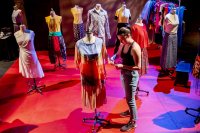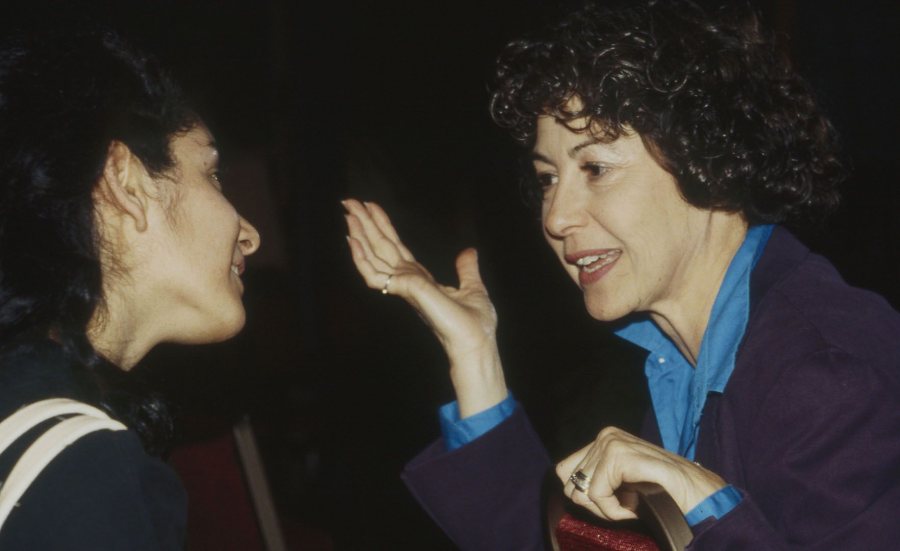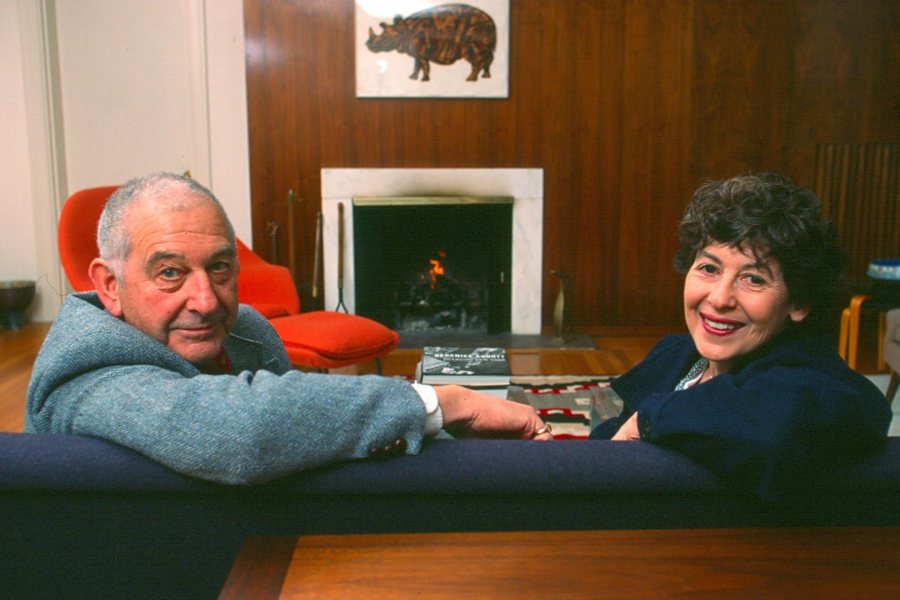
This story by Doug Hubley appeared in the Winter 1999 issue of Bates Magazine.
Look at the bare feet, hanging in the air. Some are tracing graceful spirals. Some, on the other hand, are just wiggling. The feet are attached to legs (thank goodness), extended and loosely bent at the knee, and the legs belong to some 15 student dancers at work in Room 86, upstairs in Merrill Gym.
Marcy Plavin, her slight but athletic form topped with a tangle of dark hair, is leading a class in modern dance technique. Plavin speaks, she moves, and the students do what she does. More or less.
If you know nothing about dance, a short time watching Plavin makes a fine primer. You see how moves accrue to constitute a statement. You watch the dancers bend and stretch, and you consider your latest attempt to pick a penny up off the pavement.
Your biggest lesson comes halfway through the 90-minute session. Now, propelled by cuts from Paul Simon’s Graceland, dancers advance fast in lines across the room. They walk, they turn, they generously offer a hand to no one in particular.
It just seems chaotic until — suddenly — everyone’s got the beat, got the moves, got it together. Now, bang, it’s a dance. And as dance is meant to, it’s riveting your eye, lifting your spirit.
E pluribus unum, and how.
This is the essence and symbol of what Marcy Plavin, director of dance and lecturer in dance, has been doing at Bates since 1965: making one from many, making wholes that transcend the sums of their parts. Even, at the start, making something from nearly nothing.
Back in 1965, Evelyn Dillon, head of women’s physical education at the College, saw a newspaper article and photo on Plavin’s modern dance class at the local YWCA. “It was a very funny picture,” Plavin says. “We’re all there laughing, and I’m banging a drum.” But Dillon must have gotten the beat, because she appointed Plavin adjunct instructor with two technique courses.
Three years later, Plavin formed the Bates Modern Dance Company. And by mid-March 1999, the company was ready to celebrate the 30th anniversary of its public debut. A reunion performance on the 20th (nearly coinciding with Plavin’s birthday two days later) was expected to draw alumni from across the United States to reminisce, spend yet another weekend at Marcy and Leonard Plavin’s house on Mountain Avenue — and, of course, to dance.
Among those planning to return were people like Michael Foley ’89, Suzanne Carbonneau ’76, and John Carrafa ’76, who credit Marcy Plavin with equipping them for successful careers in dance. But others have carried Plavin’s example into every sort of career. Dervilla McCann ’77 is a cardiologist in Augusta. Linda Erickson Rawlings ’76 is a founder, director, and past president of the Otis Spunkmeyer cookie company (she also founded a company for dancers over 40). Carolyn BonDurant ’97 is interning in social work in a master’s program at Smith College.
Indeed, as dance at Bates has grown through the years, so has Plavin’s network of devoted alumni, many of whom are in touch at least monthly. “I’ve never known anyone who’s gone to more weddings than Marcy and Leonard,” says friend, colleague, and neighbor Paula Matthews, associate librarian at Bates.
An emphatic speaker whose fatalistic wit betrays her New York background, Marcy Plavin is nevertheless modest and shy of public self-analysis. While those around Plavin marvel at her fabled ability to get things done — “No matter what’s happening, through obstacles along the way, she just perseveres,” says Matthews — she’s matter-of-fact about it.
“I guess if you really like what you do, you find time to do these things,” she says. “At first it was interesting, because I was teaching, I was going to school (she earned her B.A. from Maine in 1971 and master’s from Wesleyan in 1984), and I had three small children. I was trying to fit everything in. But you just do it.”
“I realized one day that I wasn’t bound by anything.”
Marcy and Leonard Plavin settled in Lewiston in the early 1960s (an area native, he owns and runs Nefco, a Lewiston company dealing in institutional furniture). Born and raised on Long Island, Marcy had found dance at the University of Wisconsin in Madison, and studied in New York with German expatriate Hanya Holm. Holm was one of the four figures considered the founders of American modern dance, with Martha Graham, Doris Humphrey, and Charles Weidman.
Plavin still regards Holm as a key influence. Unlike Graham and Humphrey, Holm emphasized developing a strong body, physical capability, rather than a signature style. Working with Holm, Plavin says, “I realized one day that I wasn’t bound by anything, that there was this tremendous freedom of where to go, what to do, what you use, and what you were going to choreograph.”
In turn, Plavin has instilled in her students this freedom to create. “They can take the creative process with them in anything that they do in their lives,” Plavin explains.
“It was incredibly different and open and freeing to have part of our experience be about being creative.”
Carolyn BonDurant, for example, used her Bates dance training to break through to high-risk children in a fifth-grade program she ran last year. “I called Marcy after the first group that we had and told her all about it,” she says. “In some ways she had given me the courage to try something like that, which was for me a risk and an experiment.”
The Bates academic environment in the early 1970s wasn’t much about creativity. It was mostly about button-down hard work, and Plavin’s dance program offered a right-brain change of pace. “In the midst of this very intensive academic experience, it was incredibly different and open and freeing to have part of our experience be about being creative,” says Suzanne Carbonneau of Chevy Chase, Md., a dance critic and historian who is on the faculty at the Institute of the Arts at George Mason University. “It was always about exposing us to a lot of different stuff and encouraging us to go where our interests were.”
Dervilla McCann remembers her first impression of a Plavin class. “It was an old gym,” she says (the so-called Women’s Gym, in the present Muskie Archives). “And in it was a dark-haired, muscular, vivacious, beautiful woman who had a group of people doing everything she said. Immediately. I mean, she was in complete control.”
In 1971, for the third annual Bates Modern Dance Company concert, the company chose The Who’s rock opera Tommy. “There was a guy on the track team who didn’t want to cut his hair” (coach Walt Slovenski was a stickler) “so he was removed from the team,” says Plavin. “We grabbed him immediately — Matthew Cassis ’72 — and we said, ‘This is our Tommy.'”
The show packed the house for two nights, an auspicious start to a decade studded with milestones for Plavin and the dance program. Still, if performances drew big crowds, support in between shows wasn’t always so forthcoming.
“I felt that Bates had a hard time considering [dance] as a serious pursuit,” says director-choreographer John Carrafa, a former member of Twyla Tharp’s company. He recalls the school giving sports teams lunch on road trips while the dancers had to shift for themselves. “Marcy, I felt, was really fighting, in a clever and non-threatening way, to establish the dance group.”
“People had to understand that dance is coming from another place,” Plavin says. In the arts, book learning only goes so far. “If you don’t act, how are you going to learn how to act?” she says. “So it’s the same thing with dance, and I think people finally understand what it’s all about.”
It wasn’t until the mid-’70s that the academic dance courses moved from physical education into the Department of Theater and Rhetoric. And the lack of sufficient space for dance programs was a pressing issue early on — still is, really — but at least nowadays Plavin no longer needs to explain why dance students even need space.
Today, while there’s no dance major at Bates, majors in theater can pursue a secondary concentration in dance. Bates’ strong reputation for dance also derives from its active role in the American College Dance Festival Association. Bates has played host to the regional ACDF five times (more than any other school), and Plavin’s dancers have repeatedly won honors at ACDF events. Each year, a series of name choreographers serve as artists in residence on campus.
1973 found Plavin introducing dance to Short Term. The unit, now titled Dance as a Collaborative Art, is based on something Plavin tried that first spring: She or a guest choreographer sets a piece on the dancers, who then bring the work to elementary schools in the region for work with small groups of pupils, and a performance. The program annually brings Bates dancers to some 4,000 elementary school pupils in the region.
“We are sometimes the only arts event some of these schools get, which is frightening,” Plavin says. “And then if we don’t go I feel guilty.”
A sobering, if ultimately instructive, brush with the big kids came in 1976 when Plavin invited Ray Cook, from the Dance Notation Bureau (a prestigious repository of dance scores written in “Labanotation”) to come and set two classics of modern dance, by Weidman and Humphrey, on her dancers.
Plavin was the first woman they had ever known who was successfully “having it all.”
“He was demanding and harsh,” says Plavin. Tears flowed, and some dancers walked off the project. Others, like Carbonneau, realized the importance of this close encounter with modern dance tradition. Cook, says Plavin, “made dancers out of those who stayed, and they performed beautifully.”
For many of her female proteges, as feminist consciousness crept northeastward to Bates, Plavin was the first woman they had ever known who was successfully “having it all” — career, creative life, and family.
“I remember her dyeing leotards in her kitchen sink” for student performers, says Geri FitzGerald ’75, a New York publishing executive and former president of the Alumni Council. “She just did it all.”
Nowadays Plavin gets more help with costumes, promotion, and other aspects of production, but her energy and agelessness have always struck awe into observers. McCann remembers that Plavin’s son (David ’77) was in one of her classes, “so I knew she had to be old enough to be my mom, but it was very difficult to believe, looking at her.”
“We saw her integrating all aspects of her life,” Carbonneau laughs, “because we spent so much time at her house.”
Leading by example was just one tactic for dealing with the growing demands of the dance program. “Marcy just has a really nice way about her where you don’t feel like you’re being forced to do anything,” says Linda Rawlings. “But you can’t say no.”
Plavin’s teaching and example lit her students’ paths, even if they didn’t know it at the time.
When he joined Twyla Tharp, says John Carrafa, his colleagues were dancers with master’s degrees or experience starting in childhood. He had graduated with a biology degree from a school with no dance major and had no exposure to modern dance before Plavin. “I found out that I had had really great training,” he says.
In February 1989, during his senior year, Michael Foley couldn’t decide whether to dance a piece he had composed for the American College Dance Festival. This simple case of indecision, mixed with end-of-college pressures, had blown up into a full-fledged personal crisis. Then Foley received a letter from Plavin that not only helped him through the crisis, but became the turning point in his dance career.
Plavin wrote simply that he had the potential to make it in dance and that doing the piece would prove it. Foley went ahead with the piece and was one of six, out of 45 contenders, selected for the festival’s gala performance. “I would not have done any of this if I had not received that letter from Marcy,” says Foley, who routinely makes space in his international teaching and choreography career to work at Bates.
One of Plavin’s own big experiments began in 1983, when she and a colleague presented the first Bates Dance Festival, a month-long summer dance celebration that today has an international reputation. The festival’s credibility was established in those early years with such big-name participants as Paul Taylor, the American Ballet Theatre, and Jacques D’Amboise, a Lewiston native who became a major dancer with the New York City Ballet. (No longer director of the festival, Plavin now serves as a consultant. She’s also a festival student, routinely taking classes.)
“Marcy is a champion of the individual.”
Wherever they find themselves two, 10, or 30 years after graduating, many of Plavin’s former students define their Bates experience by their time in the dance program. That’s not just nostalgia. The program and its architect reflect, in many ways, the Bates ideal.
“Our dance classes tended to have people of very different techniques and backgrounds, but she always seemed to incorporate every student into the class somehow,” rather than pitching only to the high or the low achievers, says Sally Gurall ’94, an administrator at Harvard Medical School. “Marcy got the whole spectrum of people interested.”
And in a time when women weren’t always treated as equals to male students (despite the College’s coed origins), Plavin’s total blindness to superficial characteristics set an example. “Marcy is a champion of the individual,” says McCann.
“She doesn’t wait for students to come to her,” says Carbonneau. “She seeks out students. She grabs them right off the quad.” Football and lacrosse players are among those who have found themselves on stage in a Plavin dance.
Plavin is also one of those often-touted, seldom-encountered individuals known as lifelong learners. She takes classes. She voraciously collects dance materials from videos to magazine clips, and has built a considerable reference section in the Ladd Library. She attends dance performances from New York to Oregon.
“She really stays in touch with what’s going on all the time, and that contributes constantly to her thinking, her ideas, so her own style evolves all the time,” says colleague and friend Bill Matthews, the Alice Swanson Esty Professor of Music.
Finally, while every college strives to maintain close ties with alumni, Plavin is the heart of a community of interest that is based on genuine friendship (see sidebar). Between her electronic organizer and her capacious memory, she can tell you where her graduates are, what they’re doing and, probably, when their and their children’s birthdays are.
Is she, after all, a symbol of Bates?
By mid-March, planning for the 30th-anniversary event was nearly finished. The concert performance would feature dance pieces performed by more than 150 Bates alumni, some returning from as far away as Central Europe, all of whom have participated in Plavin’s dance program over the last three decades. It promised to be a concert not to miss.
Plavin would agree, for sure. But again she retreats when pressed on the significance of it all. Is she, after all, a symbol of Bates?
“I don’t know about that,” she says. “I’ve enjoyed very much what I’ve done at Bates, and obviously the students — many of them — who have worked with me have enjoyed it, as well.
“I feel that if I’ve touched their lives in some way, it’s not so much that they remember me but they remember their experience at Bates, that it’s been successful for them.”
Leonard Plavin has joined the conversation. “She’s truly their mentor,” he says.
Marcy Plavin corrects him. “Friend.”






